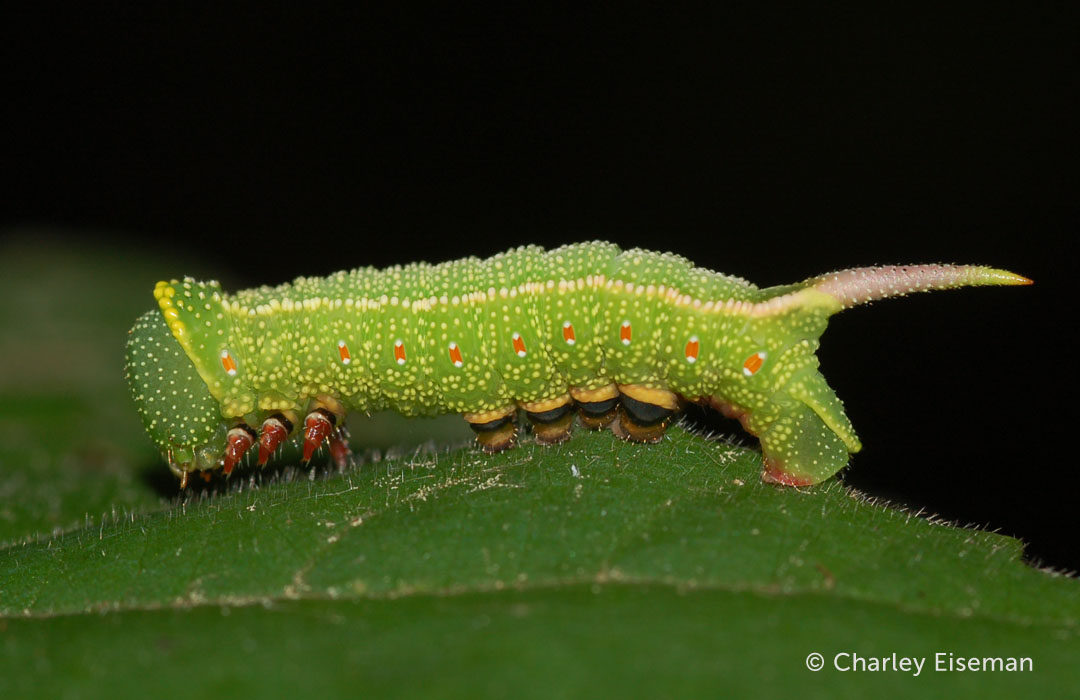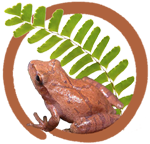Clearwing Sphinx Moth – Hummingbird of the Insect World
A Nature Vignette by Lang Elliott
While enjoying a summer flower garden, have you ever been surprised by the sudden arrival of a dwarf-sized hummingbird, smaller than any you’ve ever seen before? Chances are, it’s not a bird at all, but rather is a “hummingbird moth,” a member of the Sphinx Moth family (Sphingidae) and quite possibly the common and widespread Clearwing Sphinx Moth, Hemaris thysbe.
The Clearwing Hummingbirds, as they are often referred to, are found across much of North America, although they are most abundant in the East. They can be recognized by their olive-green back, dark burgundy-red abdomen, and reddish-brown wings with large, transparent “windows” (hence the name “Clearwing”). They are white underneath.
I see Clearwing Hummingbirds every year in midsummer, visiting flowers in our bee-balm (Monarda) patch. They are nectar feeders; an individual will hover and insert its proboscis into each floret as it quickly works its way around a flower head. You can’t help but fall in love with this cuddly-looking little moth!
Getting a good photo and/or video footage can be quite a challenge. No sooner do you get an individual framed and in-focus than it shifts position or else flies away. Where do they fly to? Probably to another flower patch to extract more nectar. Remember that hummingbird moths are not birds … they don’t have a nest with young to feed. Like other moths, they mate and the female lays eggs and then abandons them.
The eggs then hatch into larvae (caterpillars) that feed and grow without the help of parents and that eventually spin cocoons to protect the pupae, from which adults emerge. In the southern part of its range, there can be two breeding cycles in a single summer. In northern areas, there is only one. Adults die off as winter unfolds, with the pupae overwintering underground.
SOUND: On a calm day in a quiet area, you can hear the faint low-pitched hum of the beating wings. Bursts of higher sounds are made if the wings brush against leaves or other objects. In the featured video, you should be able to hear the humming if you wear full-range headphones or listen with speaker systems that include a subwoofer. Under normal listening conditions outdoors, the wing hum may be inaudible. Below is a recording of the wing noise, with accentuated bass:
DON’T FORGET TO ADD AUDIO!
- Range: Alaska and the Northwest Territories south through British Columbia to Oregon; east through the Great Plains and the Great Lakes area to Maine and Newfoundland; south to Florida and Texas.
- Other Species: There are four species in North America. While Hemaris thysbe is common in the East, other species may be more common in your area. For instance, Hemaris diffinis, the Snowberry Clearwing (a slightly smaller species recognized by black underside and legs) not only occurs in the East, but also ranges into the Southwest, where Hemaris thysbe does not occur.
- Fusce rhoncus tempor dolor, sit amet volutpat nunc lacinia non. Fusce rhoncus tempor dolor, sit amet volutpat nunc lacinia non. Fusce rhoncus tempor dolor, sit amet volutpat nunc lacinia non.
- Fusce rhoncus tempor dolor, sit amet volutpat nunc lacinia non. Fusce rhoncus tempor dolor, sit amet volutpat nunc lacinia non. Fusce rhoncus tempor dolor, sit amet volutpat nunc lacinia non.
What You Can Do:
If you know the whereabouts of a large patch of bee-balm (Monarda sp.), then your challenge is a simple one. Choose a warm sunny day and carefully observe the patch for a hour or so, anytime from late morning to early afternoon (during the heat of the day). If you’re patient, the chances are fairly high that you will see at least one species of hummingbird moth.
When you find a moth to observe, carefully follow its motions as it visits flower head after flower head. Note how quickly it works its way around a flower head, briefly inserting its proboscis in each flower to extract the nourishing nectar. Watching hummingbird moths feed is a delightful and engaging experience, punctuated by the fun of watching the antics of all the bumblebees (and other bees) that are sure to be happily feeding in the same flower patch.
Notes from the Author (Lang Elliott):
 Videotaping hummingbird moths is a challenging proposition. One big problem is that they’re continuously vibrating, not only their wings but their bodies too. So it’s difficult to get a sharp rendition of their hovering. If slow shutter speeds are used for natural motion, the wings will almost disappear. Of course, this is actually the way they look if you observe one hovering.
Videotaping hummingbird moths is a challenging proposition. One big problem is that they’re continuously vibrating, not only their wings but their bodies too. So it’s difficult to get a sharp rendition of their hovering. If slow shutter speeds are used for natural motion, the wings will almost disappear. Of course, this is actually the way they look if you observe one hovering.
The entire video is shown at half-speed slow motion, in order to slow the movements somewhat. The result is still quite natural, and gives the eye a little more time to take it all in. The sound track, in contrast, is presented at normal pitch and includes the sounds of nearby bumblebees. Altogether, I’m pretty happy with the result! Whatya think? Does the video footage convey their “essence” or “way of being”?
Learn more about Lang at langelliott.com
Did you enjoy this intimate glimpse into the natural world?







Your blogs (and sounds and comments on same) are fascinating and enlightening. Would love to help with finances but can’t handle Paypal, other on-line arrangements. Would it be possible for you to just publish a US Postage address?
Sure … you’ll find our address at the bottom of this page:
https://miracleofnature.org/donate
Lang